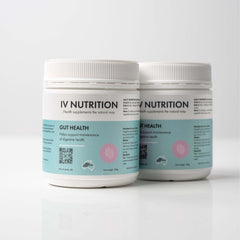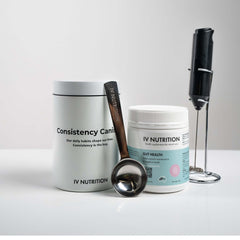The Gut–Skin Axis: Understanding the Link Between Digestive Health and Skin Health
In recent years, scientific research has increasingly highlighted the connection between the gut and the skin—an interaction now widely referred to as the gut–skin axis. This emerging field of study suggests that the composition and activity of the gut microbiota not only affect digestion, metabolism, and immunity but also play a pivotal role in the health and appearance of our skin.
For women and men alike, conditions such as acne, eczema, psoriasis, and premature aging may be directly influenced by microbial imbalances in the gut. This insight has sparked a new era of dermatological and nutritional care, where targeting gut health becomes a cornerstone of treating chronic skin disorders.
In this article, we’ll explore the science of the gut–skin axis, review key mechanisms linking the microbiome to dermatology, and discuss how prebiotic fibers, especially IV Nutrition’s Virgin Manufactured Sugarcane Prebiotic Fiber, can naturally support both gut and skin health.
Table of Contents
What Is the Gut–Skin Axis?
The gut–skin axis refers to the bi-directional relationship between the gut microbiome and the skin. Research demonstrates that disturbances in gut microbial composition (dysbiosis) can trigger or worsen skin conditions through immune activation, systemic inflammation, and metabolic disruption. Conversely, chronic skin inflammation can alter gut physiology, creating a feedback loop (Journal of Clinical Medicine).
This concept dates back to early 20th-century dermatology, when researchers John H. Stokes and Donald M. Pillsbury first hypothesized that anxiety-induced gut disturbances could lead to skin issues like acne. Modern research is now validating these early theories with cutting-edge microbiome science.
The Gut Microbiota: A Quick Overview
The human gut hosts over 100 trillion microorganisms, primarily bacteria belonging to the Firmicutes, Bacteroidetes, Actinobacteria, and Proteobacteria phyla. These microbes:
-
Digest dietary fibers into short-chain fatty acids (SCFAs).
-
Regulate immune responses.
-
Influence systemic inflammation and oxidative stress.
-
Interact with hormones and neurotransmitters.
When balanced, this ecosystem maintains both gut and skin health. But dysbiosis—an imbalance of harmful versus beneficial bacteria—has been linked to both gastrointestinal disorders (IBS, IBD) and dermatological conditions.
How Gut Health Affects the Skin
Immune System Regulation
About 70% of the immune system resides in the gut. A balanced microbiota helps train immune cells to distinguish between harmless and harmful signals. When disrupted, the immune system may trigger skin inflammation seen in acne, psoriasis, or eczema (Nature Reviews Immunology).
Metabolites and Short-Chain Fatty Acids
Fermentation of dietary fiber produces SCFAs (butyrate, acetate, propionate), which:
-
Reduce systemic inflammation.
-
Strengthen the skin barrier.
-
Influence sebum production and keratinocyte health.
Deficiencies in SCFAs due to low fiber intake are strongly associated with chronic inflammatory skin conditions.
Gut Permeability and Systemic Inflammation
A “leaky gut” allows bacterial fragments (lipopolysaccharides, LPS) to enter circulation. This systemic inflammation can worsen skin disorders, particularly psoriasis and acne (Frontiers in Microbiology).
The Role of the Gut–Brain–Skin Axis
Stress alters gut microbiota composition, and gut-derived metabolites influence neuroendocrine signaling. This explains why anxiety often worsens acne and eczema—the gut, brain, and skin are tightly interlinked.
Skin Conditions Linked to Gut Imbalances
Acne
-
Associated with dysbiosis marked by overgrowth of inflammatory Proteobacteria.
-
Low microbial diversity linked to higher severity (Frontiers in Microbiology).
-
Probiotics and prebiotics shown to reduce acne lesions by lowering systemic inflammation.
Atopic Dermatitis (Eczema)
-
Altered gut flora in early life predicts eczema development.
-
Supplementation with Bifidobacterium and prebiotics reduces eczema severity in children and adults (Allergy Journal).
Psoriasis
-
Strongly associated with intestinal permeability and dysbiosis.
-
Patients show reduced SCFA-producing bacteria and increased inflammatory strains.
Rosacea
-
Gut disorders such as small intestinal bacterial overgrowth (SIBO) are more common in rosacea patients.
-
Eradication of SIBO has been shown to improve rosacea symptoms (Clinical Gastroenterology and Hepatology).
Skin Aging
-
Chronic inflammation (“inflammaging”) driven by gut imbalance accelerates skin wrinkling, elasticity loss, and collagen breakdown.
-
SCFA production from prebiotics protects against oxidative stress.
The Role of Supplements in Supporting the Gut–Skin Axis
Probiotics
Probiotics restore balance to the gut microbiota. Clinical trials show:
-
Lactobacillus rhamnosus GG reduces eczema incidence in infants (Clinical & Experimental Allergy).
-
Probiotics improve acne severity and skin barrier function.
Prebiotics
Prebiotics (indigestible fibers) selectively feed beneficial bacteria. Benefits include:
-
Increased SCFA production.
-
Reduced systemic inflammation.
-
Enhanced skin hydration and elasticity.
Synbiotics
Combining probiotics with prebiotics (synbiotics) enhances survival and colonization of beneficial microbes, amplifying skin health benefits.
Other Key Nutrients
-
Omega-3 fatty acids: Anti-inflammatory, support skin barrier.
-
Vitamin D: Regulates immune response and microbiota balance.
-
Zinc: Supports wound healing and reduces acne inflammation.
Prebiotic Fibers: A Natural Ally for Skin Health
Among supplements, prebiotic fibers stand out for their ability to nourish beneficial bacteria and enhance microbial resilience. Unlike probiotics, which are living organisms, prebiotics are more stable and consistently effective.
For skin health, prebiotics:
-
Feed SCFA-producing microbes that calm skin inflammation.
-
Improve gut barrier function, lowering systemic “inflammaging.”
-
Promote hydration and collagen synthesis indirectly through immune regulation.
A 2021 review in Nutrients confirmed that prebiotic supplementation significantly improved skin barrier integrity and reduced inflammation across several dermatological conditions (Nutrients Journal).
Spotlight: IV Nutrition’s Virgin Manufactured Sugarcane Prebiotic Fiber
For those seeking an effective, natural, and well-tolerated prebiotic supplement, IV Nutrition’s Virgin Manufactured Sugarcane Prebiotic Fiber is a standout option.
What Makes It Unique?
-
Virgin manufactured from fresh sugarcane—not an industrial byproduct.
-
Rich in soluble fiber, ideal for supporting SCFA-producing gut bacteria.
-
Gentle on digestion, suitable even for individuals with sensitive guts.
-
Sustainably sourced and clinically designed for gut health.
Benefits for Gut–Skin Health
-
Promotes microbial diversity, strengthening the gut–skin axis.
-
Supports SCFA production, which combats inflammation-driven skin conditions.
-
Improves bowel regularity, reducing systemic inflammatory load.
-
Enhances resilience against acne, eczema, and premature aging.
Special Offer: 100% OFF Your First Tub
You can try it risk-free today with a free first tub upon subscription:
Claim Your Offer Here
This makes it an accessible, natural starting point for anyone looking to support both gut and skin health simultaneously.
Lifestyle Strategies That Support the Gut–Skin Axis
Supplements work best alongside lifestyle interventions:
-
Diet: Emphasize high-fiber fruits, vegetables, legumes, and whole grains.
-
Hydration: Supports skin elasticity and microbial activity.
-
Stress reduction: Practices like yoga and meditation reduce stress-induced dysbiosis.
-
Sleep hygiene: Adequate rest stabilizes both gut and skin circadian rhythms.
-
Limit alcohol and processed foods: These disrupt microbiota balance.
Clinical Perspectives and Future Research
The gut–skin axis is an evolving field. Future directions include:
-
Personalized microbiome testing to tailor supplements for skin health.
-
Postbiotic therapies—using microbial metabolites like SCFAs directly.
-
Investigating microbiota-targeted treatments for conditions like melanoma and autoimmune skin disorders.
The evidence strongly suggests that gut-directed interventions will become a cornerstone of dermatology and holistic medicine in the coming years.
Conclusion
The gut–skin axis highlights the intimate connection between our digestive system and skin health. Imbalances in gut microbiota can trigger or worsen skin conditions such as acne, eczema, psoriasis, and rosacea, while supporting the gut with targeted supplements and lifestyle changes can dramatically improve skin outcomes.
Prebiotic fibers, particularly IV Nutrition’s Virgin Manufactured Sugarcane Prebiotic Fiber, offer a safe, effective, and natural way to restore microbial balance, reduce inflammation, and enhance both gut and skin health.
By addressing skin issues at their root—through gut health—we can move beyond surface-level treatments and embrace a more holistic, clinically validated approach to long-term skin vitality.





